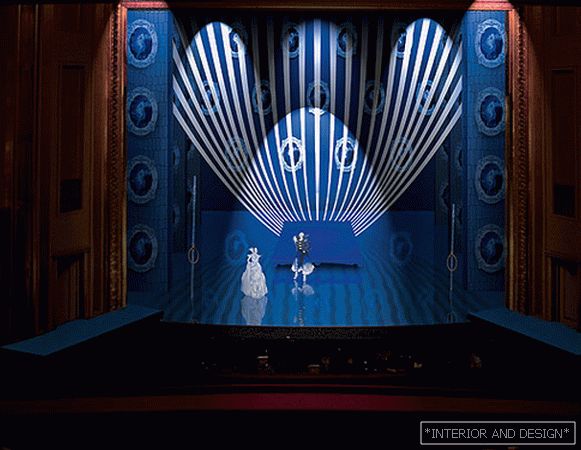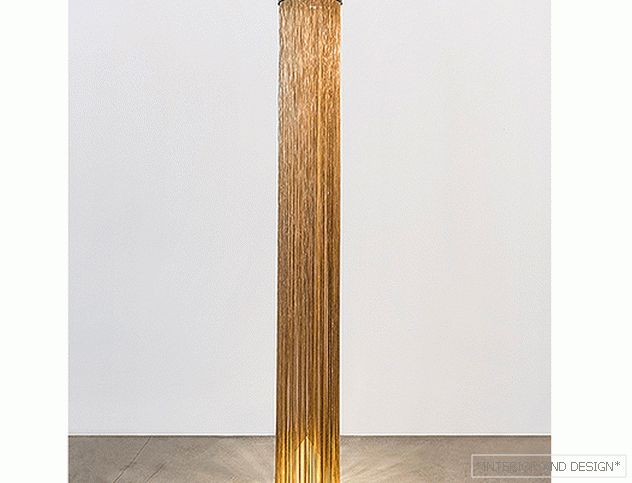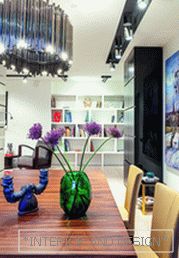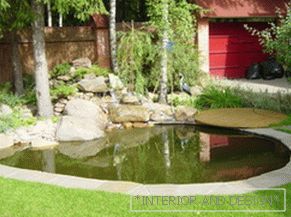 The landscaping of the backyard plot implies not only landscaping the territory, a breakdown of flower gardens and lawns, equipment for pavements, the presence of gazebos, but also the arrangement of an artificial reservoir. It has long been known that water has an amazing ability to calm and relax. Contemplation of the water surface brings people a sense of absolute comfort and complete unity with nature.
The landscaping of the backyard plot implies not only landscaping the territory, a breakdown of flower gardens and lawns, equipment for pavements, the presence of gazebos, but also the arrangement of an artificial reservoir. It has long been known that water has an amazing ability to calm and relax. Contemplation of the water surface brings people a sense of absolute comfort and complete unity with nature.
Maybe this circumstance serves main cause that many homeowners began to create artificial ponds on their plots.
Content
- 1 What begins the creation of the pond
- 2 Styles pond design
- 3 The choice of location, size and material of the pond
- 4 Technology create a pond
- 5 Plants and fish for the pond
- 6 The main mistakes in the arrangement of ponds
What begins the creation of the pond
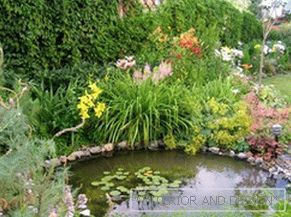 Creating a pond starts with its design taking into account the size, shape and landscape of the land. The project begins with the selection of the location of the pond and its shape. The larger the garden area, the larger the pond can have. Although even a small and shallow pond can become true decoration plot.
Creating a pond starts with its design taking into account the size, shape and landscape of the land. The project begins with the selection of the location of the pond and its shape. The larger the garden area, the larger the pond can have. Although even a small and shallow pond can become true decoration plot.
When designing, the following circumstances should be considered:
- pond shape selection (square, round or sinuous);
- the water in the pond should not be under direct sunlight for more than 6 hours a day, otherwise algae and bacteria will actively multiply in the water;
- the possibility of withdrawing water from the pond and replenishing it with the help of thawed or storm water or from the nearest spring.
Pond styling
The style of the pond should match the style of the country house and всего plot. There are two main styles:
- formal;
- free.
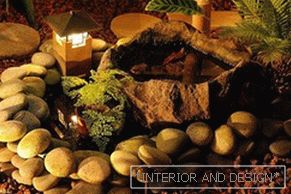 The formal style of the pond is characterized by correct, sometimes slightly smoothed. geometric outlines (square, oval, circle, ellipse, polygon). To the greatest extent, this style is used when equipping a pond at a country site small size. As a rule, a pond of regular geometric shape is separated from the rest of the landscape.
The formal style of the pond is characterized by correct, sometimes slightly smoothed. geometric outlines (square, oval, circle, ellipse, polygon). To the greatest extent, this style is used when equipping a pond at a country site small size. As a rule, a pond of regular geometric shape is separated from the rest of the landscape.
The purity of the water in the pond provide plants in the regeneration zone, separated from the main pool by a separation barrier. To finish such a pond usually use mosaic or stone. It can be decorated with the device of fountains, small waterfalls, bridges or various lights.
Formal ponds include elevated above the ground shallow reservoirs with a diameter of up to 1.2 meters, which are equipped on the terrace. Plants near such a mini pond land in boxes or cocks.
These ponds look great. in small paved gardens, visually increasing their space. They also blend well with the patio or patio, especially if there are broken flower beds or paved walkways.
Free style requires spaciousness and appropriate style of garden planning. He must be deep enough (minimum depth is 50 cm) and have an area of at least 5 m2.
The wrong shape of the banks of the pond give it a sense of naturalness. On the shore of such a pond necessarily coastal plants are planted (cattail, fern, iris, Volzhanka), which make it indistinguishable from the natural pond.
The stream flowing into it looks natural, for arranging it is rather insignificant height differences between the beginning of the stream and the shore of the pond.
If you want to create a pond by erecting a dam on a natural stream, then it is better to initially predesign studies so as not to cause later local ecological catastrophe (waterlogging or drainage of the territory).
It is not recommended to build ponds on sites swampy soil and where there are problems with water.
The choice of location, size and material of the pond
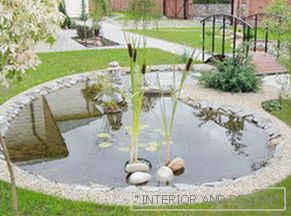 When choosing the location of the pond, it is important to keep in mind that the pond in the suburban area performs decorative role and is not intended for swimming or breeding fish. The correct choice of the location of the pond is a guarantee of its long functioning without spring and summer flowering.
When choosing the location of the pond, it is important to keep in mind that the pond in the suburban area performs decorative role and is not intended for swimming or breeding fish. The correct choice of the location of the pond is a guarantee of its long functioning without spring and summer flowering.
An important role when choosing a place for a pond is played by the illumination of the future water surface. It is desirable that the sun hit the water at the beginning of the first or the end of the afternoon. In the afternoon, the water surface should hide behind the shadow planted along the banks of plants. The pond should be lit by the sun no more than 6 hours a day and be open from the south-west.
The optimal pond size should not exceed 3% of the area приусадебного plot. При определении размеров пруда необходимо учитывать гармоничность его восприятия, то есть его размеры должны match with other elements landscape.
According to the depth of the pond, it is desirable to divide into three zones:
- coastal;
- shallow;
- deep (for wintering fish).
The pond should not be made too deep - enough 150 - 180 cm (below the depth of soil freezing). The deepwater area should be approximately 20% of the total pond area.
As a material for creating a pond can be used:
- concrete pit (used for ponds of regular geometric shape);
- the use of finished plastic containers (their disadvantage lies in a strictly defined shape and small volume);
- the use of a special moisture-resistant film for laying out the pond bowl (used to create a pond on an individual project).
Pond creation technology
Creating a pond на основе готовой емкости проводится easy and fast within 2 days and includes the following steps:
-
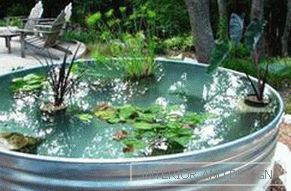 In the place chosen under the pond, set the capacity on the bricks. Its contours on the ground are marked with light sand or lime.
In the place chosen under the pond, set the capacity on the bricks. Its contours on the ground are marked with light sand or lime. - Along the outlined contours, extending the markings by 10 cm, a pit is carefully dug, the base of which is carefully tamped.
- Capacity is installed in the pit. With the help of the level it is necessary to ensure that the capacity is set strictly horizontally.
- The bowl of the tank is filled with water by a third, and the space between the walls of the pit and the tank is filled with sand, which is periodically watered.
Ponds of arbitrary shape are created using a waterproofing film of polyethylene, PVC or butyl rubber. The best is considered butyl rubber film. Its thickness depends on the depth of the pond: if the depth does not exceed 80 cm, then the thickness of the film used is equal to 0.8 mm, otherwise - 1.5 mm.
The stages of pond construction using film technology are as follows:
-
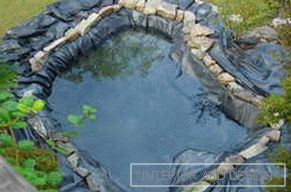 Light sand or lime outlines are indicated shores of the pond and contours for different depths.
Light sand or lime outlines are indicated shores of the pond and contours for different depths. - The excavation is dug, starting from a less deep zone.
- The bottom of the pit is filled with sand, which fits geotextile or fizelin, serving as protection for the film from stones and roots.
- A film is covered on top, the edges of which must be 50 cm beyond the edges of the pit. Stones film is pressed down to the bottom and terraces of the pit.
- Gradually the pond is filled with water. At the same time the film should settle slowly.
- A few days later the coastal zone is issued. The edges of the film are filled and stones or slabs are laid on them, the gaps between which are filled with pebbles or sand.
Plants and fish for the pond
To create a closed ecosystem in the dacha pond and maintain biological equilibrium the reservoir needs plants that are divided into:
- underwater plants (play a major role in the saturation of water with oxygen);
- plants whose roots are under water, and the stems are above water;
- plants whose roots are in watery soil, and the stems are above water;
- plants floating on water (suitable for small ponds).
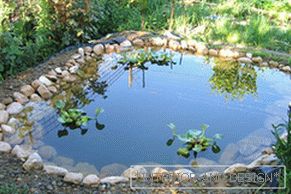 The most common aquatic plants are water lilies (water lily), which obscure the sun and prevent water from blooming. Among coastal plants around ponds there are often found underwater buttercups, a cat, a marsh marigold. Pontederia with large shiny leaves is very popular. It blooms from July to September spike-like pale blue flowers and is not afraid of frost.
The most common aquatic plants are water lilies (water lily), which obscure the sun and prevent water from blooming. Among coastal plants around ponds there are often found underwater buttercups, a cat, a marsh marigold. Pontederia with large shiny leaves is very popular. It blooms from July to September spike-like pale blue flowers and is not afraid of frost.
For registration of the banks of the pond is used air. To maintain biological balance in the pond often use a hatch, which has no roots.
Fish are an indispensable attribute of the dacha pond, making certain balance and animating it. They eat various larvae, mosquitoes and other small insects.
Пруд looks more colorful if it is inhabited by motley ornamental fish floating near the surface.
It is recommended to buy fish for the pond in the late spring - early summer, when the water in the pond warm enough. Buy better adults that are easier to adapt to new conditions. They can be settled in a pond a month after filling the pond with water and planting it with plants. This period is necessary for the establishment of a biological equilibrium in the pond.
First settled in the pond goldfish, fur coats, and then all the rest (black telescope, Japanese carp koi, golden orff, golden rudd, etc.). The number of fish in a pond depends on its size: at 0.1m2 pond area must account for 2.5 cm fish body lengths
Feed the fish once a day dry food. In the winter for some time they can be left without feeding. It is necessary to ensure that in winter the pond does not freeze to the bottom.
The main mistakes in the arrangement of ponds
Typical errors that are made during the construction of the pond are as follows:
- Unsuccessful choice of location of the pond. The pond at the bottom should have protection against hitting with melt and storm waters of various garbage. A pond on a hill or surrounded by a high earthen wall will look unnatural.
- Wrong choice of depth and shape. Maximum depth should not be less freezing depth ground. The complex form of an artificial pond looks unnatural.
- The device is too steep walls. For planting aquatic plants pond walls must be performed in the form of terraces.
- Wrong selection of plants for the pond. Plant height must be proportional to size pond, and the plants themselves must be resistant to the local climate.
- Wrong selection of fish. Can't pond overrun with fish as for their normal content requires a certain amount of water. You can not get involved in ornamental species of fish, care for which is not so simple and it is especially difficult to provide them with wintering.
- Insufficient safety for people and animals. The banks of the pond should not be slippery, the soil along the edges should not creep. To ensure the protection of small children and pets, the pond should be fenced or covered with a sturdy net on the frame.

